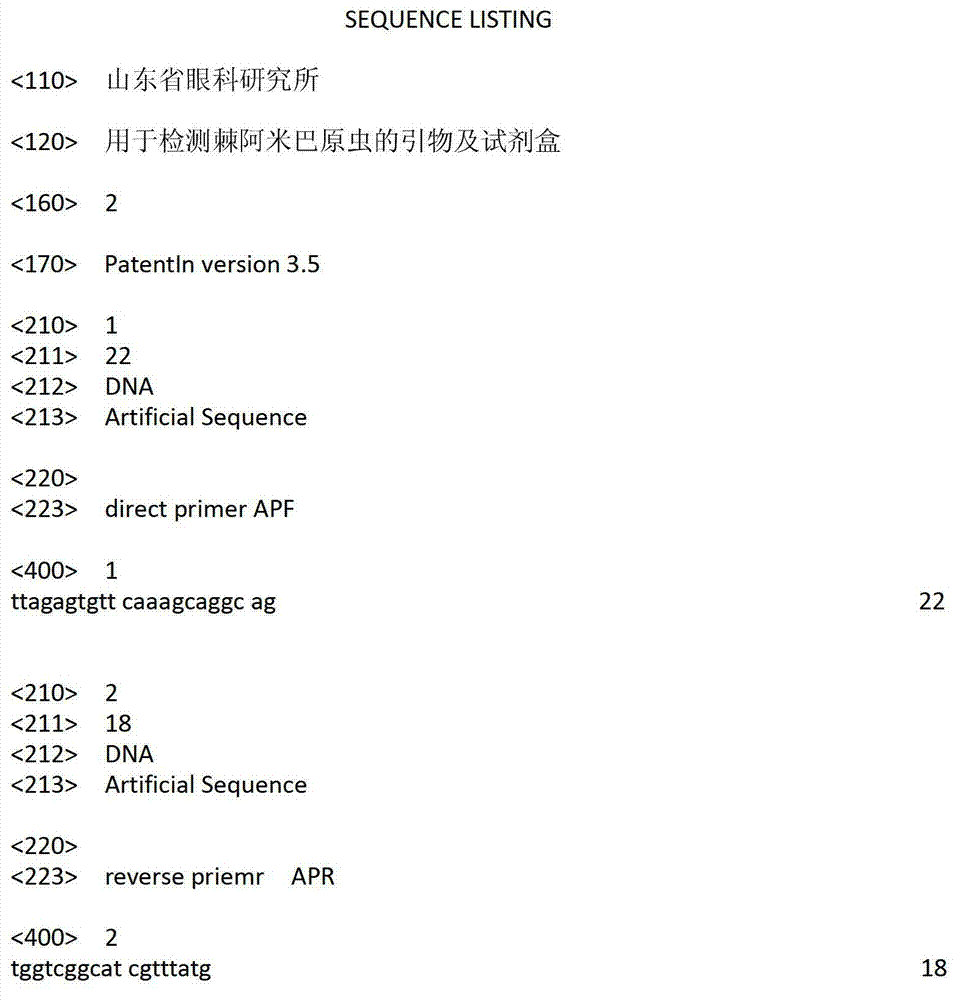Primers for detecting acanthamoeba protozoa and kit
A technology of Acanthamoeba and detection kit, which is applied in the field of primers and kits for detection of Acanthamoeba, can solve the problems of low DNA yield, difficulty in adapting to clinical needs of ordinary PCR, sample loss, etc., and achieve high Amplification efficiency, save template DNA extraction step, good effect of early diagnosis
- Summary
- Abstract
- Description
- Claims
- Application Information
AI Technical Summary
Problems solved by technology
Method used
Image
Examples
Embodiment 1
[0058] The sensitivity detection of embodiment 1 kit of the present invention
[0059] Gradiently dilute the known concentration of Acanthamoeba suspension to 10 4 ,10 3 ,10 2 ,10 1 ,10 0 copies / μL, using the DNA amplification reagent and primer combination in the kit of the present invention to amplify, and evaluate the sensitivity of direct PCR to the detection of Acanthamoeba, the specific method is as follows:
[0060] 1) 10.5 μL of DNA amplification reagent, 1 μL of Acanthamoeba suspension in each gradient, 2 μL of forward and reverse primer combinations, and 20 μL of sterilized distilled water;
[0061] 2) 98°C for 5 minutes / 98°C for 30 seconds, 65°C-60°C for 30 seconds (the temperature decreases by 0.5°C for each cycle), 72°C for 30 seconds; (9 cycles) / 98°C for 30 seconds, 60°C for 30 seconds, 72°C for 30 seconds; (25 cycles) / 72°C for 10 minutes, hold at 4°C.
[0062] 3) After the PCR reaction is completed, add loading buffer solution to each concentration gradie...
Embodiment 2
[0064] Embodiment 2: the specific detection of kit of the present invention
[0065] Utilize other common pathogens in ophthalmology, such as Staphylococcus epidermidis in bacteria, Fusarium solani in fungi, herpes simplex virus type I in viruses, and corneal epithelial cells often mixed in corneal scrapings against Acanthamoeba Primers were tested for specificity.
[0066] The specific operation is the same as the specific method of Example 1, and the results show that the Acanthamoeba primer combination in the kit of the present invention only has specific amplification for Acanthamoeba, and does not have amplification for other pathogenic microorganisms, which illustrates the present invention There will be no false positives when the primers are tested.
Embodiment 3
[0067] Example 3: Detection of animal diseased tissue samples by the kit of the present invention
[0068] Use clinically highly suspected acanthamoeba keratitis lesions corneal tissue scrapings to verify the effectiveness of the kit of the present invention, the specific method is as follows:
[0069] (1) Add 5-10 μL of sterilized distilled water to the lesioned corneal scrapings and blow until evenly distributed.
[0070] (2) Depending on the sample volume, take 1-5 μL of the above sample suspension and add it to a small PCR reaction tube, add 10.5 μL of DNA amplification reagent, then add 2 μL of Acanthamoeba primer combination, add sterilized distilled water to make up 20 μL . At the same time, make a positive control with positive nucleic acid and a negative control without template.
[0071] (3) Put the above-mentioned reaction tube into the PCR instrument for TouchDown PCR reaction: 98°C for 5 minutes / 98°C for 30 seconds, 65°C-60°C for 30 seconds (each cycle temperat...
PUM
 Login to View More
Login to View More Abstract
Description
Claims
Application Information
 Login to View More
Login to View More - R&D Engineer
- R&D Manager
- IP Professional
- Industry Leading Data Capabilities
- Powerful AI technology
- Patent DNA Extraction
Browse by: Latest US Patents, China's latest patents, Technical Efficacy Thesaurus, Application Domain, Technology Topic, Popular Technical Reports.
© 2024 PatSnap. All rights reserved.Legal|Privacy policy|Modern Slavery Act Transparency Statement|Sitemap|About US| Contact US: help@patsnap.com










